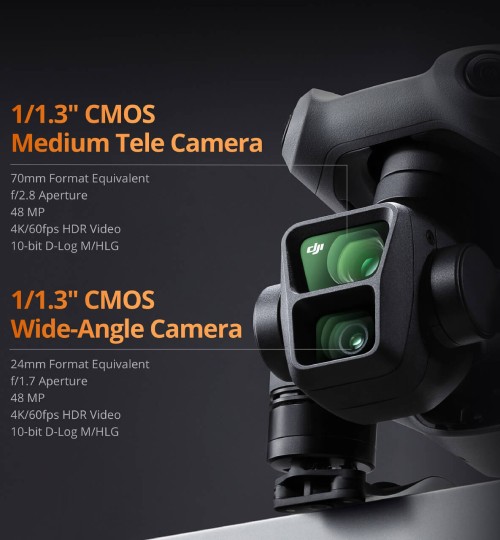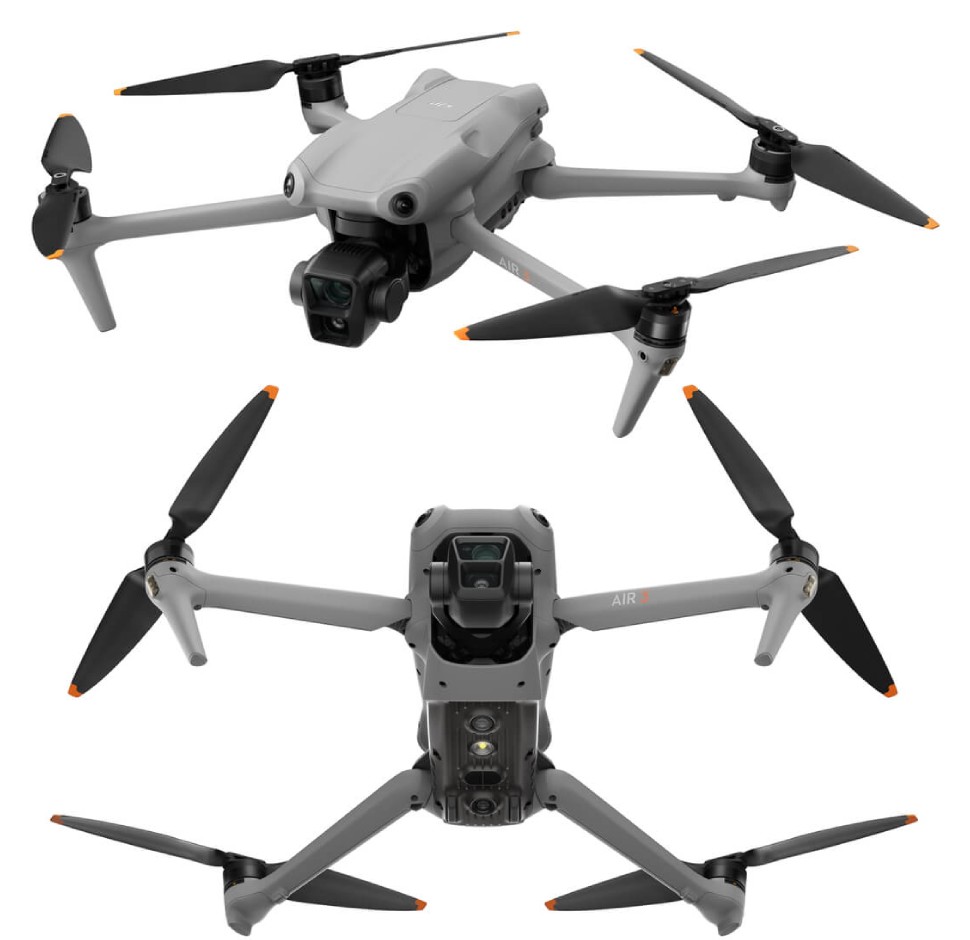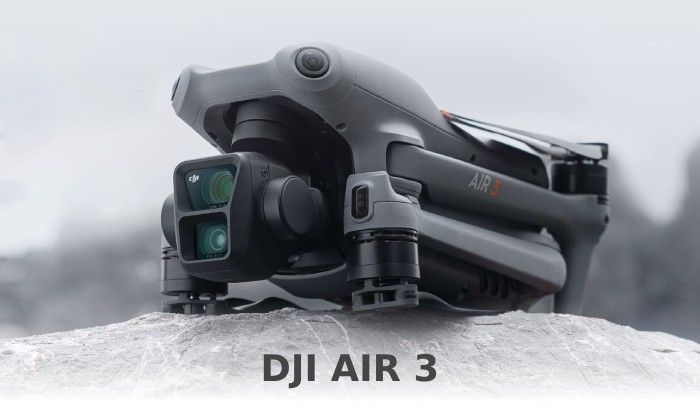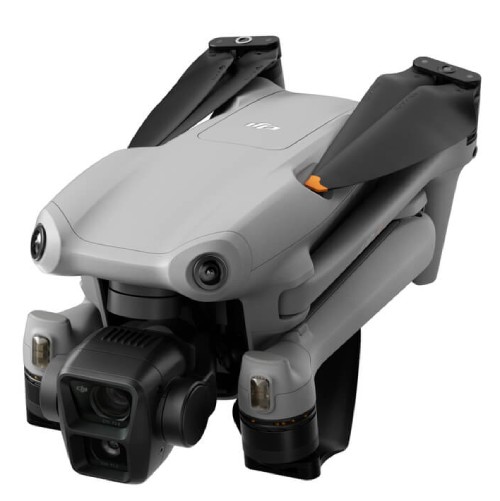Both cameras are capable of delivering 48MP photos filled with realistic detail that look great and allow for seamless cropping in post for those who need it. Unlike the DJI Mini 3's sensor, better stacking technology is used here, and accordingly the images will be better on the DJI AIR 3:


Air 3’s two 1/1.3-inch CMOS sensors support dual native ISO for direct output of 4K/60fps HDR video without cropping. This means footage from either camera can be packed with rich coloring and natural lighting transitions for breathtaking and highly-accurate results. According to specs it should also be able to record 4K/100fps content but we assume some cropping posible here for a slow motion feature.
Does DJI Air 3 support vertical shooting? Both the wide-angle camera and medium tele camera support vertical shooting (9:16), and the max shooting specification is 2.7K/60fps.
The advertised range of the new Mavic Air 3 is DJI O4 20km 1080p/60fps Transmission when working in FCC mode allowed countries.

Compared with DJI Air 2S, what are the main upgrades of DJI Air 3?
DJI Air 3 has improved the camera system, video transmission system, vision sensing system, flight time, and intelligent features. Details are as follows:
1. A 1/1.3-inch CMOS 70mm medium tele camera has been added to complement the 1/1.3-inch CMOS 24mm wide-angle camera, delivering consistent image quality* and more dynamic imaging possibilities.
2. The video transmission system has been upgraded to the next-gen O4 HD video transmission system, which not only delivers an FHD video transmission from a max range of 20 km, but also features enhanced anti-interference capabilities, further improving the transmission stability. The remote controller also supports a 1080p/60fps max real-time live feed, with the higher frame rate delivering a smoother viewing experience.
3. Equipped with an omnidirectional vision sensing system, the drone can detect obstacles in all directions. When obstacles are detected, the drone can use APAS 5.0 to perform smoother avoidance movements for a safer overall flight experience.
4. The max hovering time and the max flight time are 42 minutes and 46 minutes respectively, which are 40% and 48% higher than those of DJI Air 2S respectively, allowing you to create with peace of mind.
5. The drone supports Waypoint Flight, Advanced RTH, Cruise Control, QuickTransfer, and other intelligent functions, greatly improving creative efficiency.
The wide-angle camera and medium tele camera have different apertures.
Compared with the O3 video transmission system, what are the upgrades of the O4 video transmission system?
The O4 video transmission system adopts an all-new hardware solution. The aircraft antenna system is upgraded from four antennas to six, and a new frequency band* has been added. The communication algorithm has also been upgraded, which not only delivers an FHD video transmission from a max range of 20 km**, but also features enhanced anti-interference capabilities, further improving the transmission stability in complex environments like urban settings. The remote controller also supports a 1080p/60fps max real-time live feed, with the higher frame rate delivering a smoother viewing experience.
* Can be used only in countries and regions where it is allowed by local laws and regulations.
** Measured in an open outdoor environment without interference and with FCC compliance. The above data shows the farthest communication range for one-way, non-return flights. Always pay attention to reminders in the app during your flight.
Compared with DJI RC-N2, what are the advantages of DJI RC 2? How should I choose?
When using DJI RC-N2, you need to connect your smartphone and download the DJI Fly app. DJI RC 2 comes with a 5.5-inch 1080p FHD screen with a brightness of up to 700 nits, delivering a better outdoor viewing experience. Additionally, with the DJI Fly app pre-installed, you can enjoy immediate use after powering on without connecting to your smartphone, facilitating concentrated and efficient creation.
How is ActiveTrack 5.0 different from ActiveTrack 4.0?
ActiveTrack 5.0 can track subjects in eight directions, enabling more creative possibilities. Embedded with advanced subject recognition technology, ActiveTrack 5.0 uses multiple vision sensors simultaneously to recognize a subject, differentiate it from other objects, and lock the subject in the frame. It allows you to adjust tracking angles smoothly for more natural results. Thanks to the new environment and subject-sensing algorithms, DJI Air 3 responds earlier to subject movements and environmental information and plans an optimal tracking route to record smooth and stable footage.
Does DJI Air 3 support shooting D-Log M and HLG videos?
Both the wide-angle camera and medium tele camera support shooting 10-bit D-Log M and 10-bit HLG videos. 10-bit D-Log M mode facilitates more flexible color grading in post-production, and 10-bit HLG mode can achieve previews with higher dynamic range (requires equipment that supports HDR display).
Price estimate DJI Air 3 (DJI RC-N2) without fly more combo: 1099€
Price estimate DJI Air 3 (DJI RC-N2) with fly more combo: 1349 €
DJI store: DJI Store link
Youtube introduction: Youtube link

 EN
EN  BG
BG A bit more than 3 years after the second model - the Air 2 and 2 years after Air 2S, DJI just released their 3rd version of the popular Air model - DJI Mavic Air 3 with DJI RC-N2 remote.
A bit more than 3 years after the second model - the Air 2 and 2 years after Air 2S, DJI just released their 3rd version of the popular Air model - DJI Mavic Air 3 with DJI RC-N2 remote. The camera sensor is not the largest version of the tech like for example 1 inch size like Air2S but but it has better stacking technology, the new little hornet now has more recording power - Dual-Camera which produces 4K/60fps HDR Videos, Effortlessly Epic Imaging.
The camera sensor is not the largest version of the tech like for example 1 inch size like Air2S but but it has better stacking technology, the new little hornet now has more recording power - Dual-Camera which produces 4K/60fps HDR Videos, Effortlessly Epic Imaging.